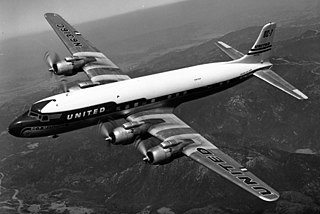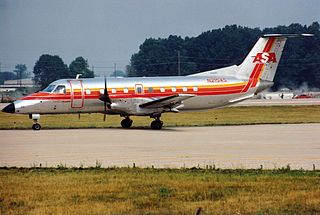
The Douglas DC-7 is an American transport aircraft built by the Douglas Aircraft Company from 1953 to 1958. A derivative of the DC-6, it was the last major piston engine-powered transport made by Douglas, being developed shortly after the earliest jet airliner—the de Havilland Comet—entered service and only a few years before the jet-powered Douglas DC-8 first flew. Unlike other aircraft in Douglas's line of propeller-driven aircraft, no examples remain in service in the present day, as compared to the far more successful DC-3 and DC-6.

Thrust reversal, also called reverse thrust, is the temporary diversion of an aircraft engine's thrust for it to act against the forward travel of the aircraft, providing deceleration. Thrust reverser systems are featured on many jet aircraft to help slow down just after touch-down, reducing wear on the brakes and enabling shorter landing distances. Such devices affect the aircraft significantly and are considered important for safe operations by airlines. There have been accidents involving thrust reversal systems, including fatal ones.

In aeronautics, a spoiler is a device which intentionally reduces the lift component of an airfoil in a controlled way. Most often, spoilers are plates on the top surface of a wing that can be extended upward into the airflow to spoil the streamline flow. By so doing, the spoiler creates a controlled stall over the portion of the wing behind it, greatly reducing the lift of that wing section. Spoilers differ from airbrakes in that airbrakes are designed to increase drag without affecting lift, while spoilers reduce lift as well as increasing drag.

Scandinavian Airlines System Flight 751 was a regularly scheduled Scandinavian Airlines passenger flight from Stockholm, Sweden, to Warsaw, Poland, via Copenhagen, Denmark. On 27 December 1991, a McDonnell Douglas MD-81 operating the flight, registration OY-KHO, piloted by Danish Captain Stefan G. Rasmussen (44) and Swedish first officer Ulf Cedermark (34), both experienced pilots with 8,000 and 3,000 flight hours, respectively, was forced to make an emergency landing in a field near Gottröra, Sweden. Ice had collected on the wings' inner roots before takeoff, broke off, and was ingested into the engines as the aircraft became airborne on takeoff, ultimately resulting in the failure of both engines. All 129 passengers and crew aboard survived.

American Airlines Flight 157, a Douglas DC-6, departed on November 29, 1949, from New York City bound for Mexico City with 46 passengers and crew. After one engine failed in mid-flight, a series of critical mistakes by the flight crew caused the pilot to lose control of the plane during the final approach to a routine stopover at Love Field in Dallas, Texas. The airliner slid off the runway and struck a parked airplane, a hangar, and a flight school before crashing into a business across from the airport. 26 passengers and two flight attendants died. The pilot, co-pilot, flight engineer, and 15 passengers survived.

United Airlines Flight 859 was a Douglas DC-8, registration N8040U, on a scheduled passenger flight that crashed on landing at Stapleton International Airport in Denver, Colorado after departing from Omaha, Nebraska's Eppley Airfield on July 11, 1961. Eighteen people were killed, and 84 were injured.

S7 Airlines Flight 778(S7778/SBI778) was a scheduled domestic passenger flight from Moscow to Irkutsk, Russia. On 9 July 2006, at 06:44 local time, the Airbus A310-324 aircraft operating the route overran the runway during its landing in Irkutsk. The aircraft failed to stop and crashed through the airport's concrete perimeter fence, struck rows of private garages and burst into flames, killing 125 people.

Trans-Canada Air Lines Flight 304 was operated by a Vickers Viscount 700 aircraft owned by Trans-Canada Air Lines. On July 9, 1956, the No. 4 propeller of the aircraft tore loose from its engine over Flat Rock, Michigan in the United States, during a flight from Chicago, Illinois, to Toronto, Ontario, and Montreal, Quebec; one blade of the propeller sliced through the passenger section of the cabin, killing one passenger and injuring four passengers and one flight attendant. The aircraft diverted to Windsor, Ontario, in Canada, and the pilots carried out an emergency landing. The accident was the first to involve a Vickers Viscount aircraft in scheduled service, and was the first instance of a propeller loss on a turbo-prop aircraft.

TAM Transportes Aéreos Regionais Flight 402 was a scheduled domestic flight from São Paulo–Congonhas International Airport in São Paulo, Brazil to Recife International Airport in Recife via Santos Dumont Airport in Rio de Janeiro. On 31 October 1996, at 8:27 (UTC-2), the starboard engine of the Fokker 100 operating the route reversed thrust while the aircraft was climbing away from the runway at Congonhas. The aircraft stalled and rolled beyond control to the right, then struck two buildings and crashed into several houses in a heavily populated area only 25 seconds after takeoff. All 95 people on board were killed, as well as another 4 on the ground. It is the fourth deadliest accident in Brazilian aviation history, the second at the time. It is also the deadliest aviation accident involving a Fokker 100.

Atlantic Southeast Airlines Flight 2311 was a regularly scheduled commuter flight from Hartsfield–Jackson Atlanta International Airport to Glynco Jetport in Brunswick, Georgia on April 5, 1991. The flight, operated using a twin-turboprop Embraer EMB 120 Brasilia, crashed just north of Brunswick while approaching the airport for landing. All 23 people aboard the plane were killed, including passengers NASA Astronaut Sonny Carter and former United States Senator John Tower. Four years later, another Embraer Brasilia of ASA crashed in the Georgia countryside in similar circumstances, with nine fatalities.

TAM Airlines Flight 3054 (JJ3054/TAM3054) was a regularly scheduled domestic passenger flight of TAM Airlines from Porto Alegre to São Paulo, Brazil. On the evening of July 17, 2007, the Airbus A320-233 serving the flight overran runway 35L at São Paulo during moderate rain and crashed into a nearby TAM Express warehouse adjacent to a Shell filling station. The plane exploded on impact, killing all 187 passengers and crew on board and 12 people on the ground. The crash surpassed Gol Transportes Aéreos Flight 1907 as the deadliest aviation accident in Brazilian territory and in South American history, and remains the deadliest aviation accident involving the A320 proper worldwide, and the second-deadliest air disaster involving the A320 family, surpassed by the bombing of Metrojet Flight 9268, an A321-231, which crashed in Egypt in October 2015 with 224 fatalities.

Spanair Flight 5022 was a scheduled domestic passenger flight from Barcelona–El Prat Airport to Gran Canaria Airport, Spain, via Madrid–Barajas Airport that crashed just after take-off from runway 36L at Madrid Airport at 14:24 CEST (12:24 UTC) on 20 August 2008. The aircraft was a McDonnell Douglas MD-82, registration EC-HFP. Of the 172 passengers and crew on board, 154 died and 18 survived.

Japan Air Lines Flight 446 was a Japan Air Lines flight from Sheremetyevo International Airport of Moscow, Russian SFSR, Soviet Union to Tokyo International Airport in Ōta, Tokyo, Japan.

American Airlines Flight 910, a four-engine Douglas DC-6 propliner, collided in mid-air with a single engine Temco Swift on final approach to Dallas Love Field on June 28, 1952, over Dallas, Texas. The DC-6 was carrying 55 passengers and 5 crew members from San Francisco, California. The DC-6 landed with no injuries to any of its 60 occupants, while both occupants of the two-person Swift died when their aircraft impacted the ground.

Kish Air Flight 7170 was a scheduled international passenger flight, operated by an Ektaban-based Iranian airlines Kish Air from Kish Island in Iran to Sharjah, United Arab Emirates (UAE). On 10 February 2004, the aircraft serving the route, a Fokker 50, crashed while approaching to land at Sharjah International Airport killing 43 of the 46 occupants. The final report, conducted by Emirates General Civil Aviation Authority, concluded that pilot error was the cause of the accident.

On 13 October 2011, Airlines PNG Flight 1600, a Dash 8 regional aircraft on a domestic flight from Lae to Madang, Papua New Guinea, crash-landed in a forested area near the mouth of the Gogol River, after losing all engine power. Only four of the 32 people on board survived. It was the deadliest plane crash in the history of Papua New Guinea.

Sita Air Flight 601 (ST601) was a Nepalese domestic passenger flight, operated by Sita Air from Tribhuvan International Airport in Nepal's capital Kathmandu to Tenzing-Hillary Airport in Lukla. On 28 September 2012, the Dornier 228 serving the route crashed while attempting an emergency landing at Kathmandu shortly after takeoff, killing all 19 people on board.

Merpati Nusantara Airlines Flight 6517 was a scheduled domestic passenger flight from Bajawa to Kupang, Indonesia. On 10 June 2013, the Xian MA60 twin turboprop operating the route crashed on the runway while landing at Kupang's El Tari Airport, injuring 25 occupants, five seriously. The aircraft was severely damaged in the impact and subsequently written off.

Air Caraïbes Flight 1501 (TX1501/FWI1501) was a scheduled international passenger flight, flying from Saint Martin Airport in the Dutch overseas territory of Sint Maarten to Saint Barthélemy Airport which was in the French overseas region of Guadeloupe at that time. The flight was operated by Air Caraïbes, a Caribbean regional airline, using a de Havilland Canada DHC-6-300 Twin Otter. On 24 March 2001, during an approach to Saint Barthélemy Airport, the DHC-6 Twin Otter banked steeply to the left and crashed into a house, killing all 19 passengers and crew on board. One person on the ground was also killed in the explosions that followed.

Overseas National Airways (ONA) Flight 032 was a non-scheduled positioning flight operated by Overseas National Airways with a McDonnell Douglas DC-10-30CF. On November 12, 1975, the flight crew initiated a rejected takeoff after accelerating through a large flock of gulls at John F. Kennedy International Airport, resulting in a runway excursion. Of the 139 aircraft occupants, all survived, while the aircraft was destroyed by an intense post-crash fire. The National Transportation Safety Board concluded that the probable cause of the accident was bird ingestion into the right-hand engine, causing an uncontained engine failure that ruptured several landing gear tires and disabled the engine's hydraulic system, in turn partially disabling the spoilers and the landing gear brakes. Contributing to the accident was the resultant failure of the affected engine's thrust reverser and the wet runway. The accident aircraft is claimed to be the largest commercial airliner ever destroyed due to a bird strike.





















